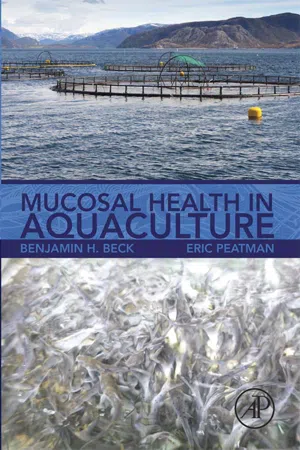1.1. Why mucosal health?
Aquaculture is the fastest growing sector of agriculture and is expected to maintain its rapid growth in coming decades in the face of rising world populations and declining wildcatch fisheries. Roughly half of all seafood for public consumption is now farmed. An ever-growing number of fish and shellfish species is either being grown commercially or being evaluated for aquaculture potential. The domestication of key species for aquaculture is still in its infancy, however, when compared with more established livestock industries such as poultry or cattle. Market demands for higher volumes of cultured product at lower prices have often come into conflict with the ability of near-wild species to cope with intensive aquaculture environments. Resulting disease outbreaks (whether virus, parasite, or bacteria) inflict significant economic, public perception, and marketing damage to the growing industry. Prioritizing the broad-based health of cultured species is critical in avoiding these boom/bust cycles and establishing the sustainable growth of the aquaculture industry worldwide.
Rather than recapitulating the more familiar textbook and cataloging fish pathogens and their treatments, here we choose to focus on the health and immunity of the cultured organism. Ultimately, the goal of the aquaculture industry is to optimize environmental parameters, dietary regimens, and host genetics such that disease events are rare. These factors intersect in the mucosal surfaces of cultured aquatic organisms. The mucosal surfaces (skin, gill, and intestine) constitute the first line of defense against pathogen invasion while simultaneously carrying out a diverse array of other critical physiological processes, including nutrient absorption, osmoregulation, and waste excretion. Aquaculture species depend more heavily on mucosal barriers than their terrestrial agricultural counterparts as they are continuously interacting with the aquatic microbiota. Unlike classical immune centers, such as the spleen and kidney, the accessibility of mucosal surfaces through immersion/dip treatments or dietary changes allows tailored chemical and nutritional strategies to maximize mucosal and, therefore, organismal health. Indeed, many areas of intense research in aquaculture over the last decade have hinged upon a better understanding of mucosal health. Nutritionists are hard at work studying the impacts of antinutritional factors in plant-based fish diets on gut mucosa and how to circumvent them. Feed companies are competing to produce superior immunostimulants, prebiotics, and probiotics that maximize mucosal health and decrease disease prevalence. Microbiologists and immunologists are studying mechanisms of pathogen adherence and entry through mucosal surfaces and designing attenuated mucosal vaccines to stimulate robust mucosal protection. This text cuts across all of these areas in order to capture and bring together our latest understandings of mucosal barriers in aquaculture species and their impacts on nutrition and immunity. Beginning with an in-depth overview of mucosal immunity in fish (Chapter 2, Castro and Tafalla), the book synthesizes our current understanding of the fish structure and function (Chapter 3, Peterson), fish skin (Chapter 4, Esteban and Cerezuela), gill (Chapter 5, Koppang, Kvellestad, and Fischer), and gut/intestinal (Chapter 6, Salinas and Parra) barriers, before looking at the impacts of the environment (Chapter 7, Sundh and Sundell), nutrition (Chapter 8, Trushenski), prebiotics and probiotics (Chapter 9, Caipang and Lazado), and the microbial community (Chapter 10, Merrifield and Rodiles) on these same surfaces. Chapter 11 (Soto, Griffin, and Tobar) considers the progress and potential of new vaccines seeking to protect aquacultured organisms at these barriers. Chapter 12 (Allam and Espinosa) provides a detailed investigation into mucosal health in shellfish.
Studies on immunity in aquacultured species, as a whole, have either been comparative in nature, seeking to catalog the presence or absence of components of immunity expected based on knowledge of mammalian immunology, or oriented around artificial disease challenges, with little or no examination of underlying mechanisms. However, an array of new cellular and molecular tools that has become available over the last several years is rapidly changing this. To close out the book, Chapter 13 (Beck and Peatman) focuses on new, promising approaches to understanding the mucosal interactome, a term used to describe the intricate co-regulation of host immunity, environmental signaling, pathogen dynamics, and the broader microbial community at mucosal surfaces.
The future looks bright for global aquaculture, with a growing middle class and an array of new, more sustainable production models and diets that promise to lower costs and reduce waste output. The key to continued success, however, rests in maintaining the health of cultured organisms season after season. Understanding how culture practices, system specifications, and nutrition can impact mucosal health and enhance or decrease disease prevalence puts control in the hands of producers and brings a needed predictability to a growing industry. It is our hope that this book serves as an important step in that direction.
